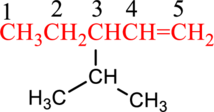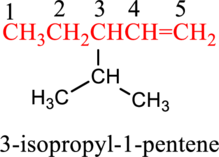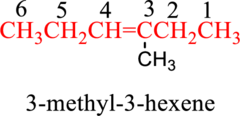
Concept explainers
(a)
Interpretation:
IUPAC name of given below compound has to be given.

Concept introduction:
IUAC gives rules for the naming of chemical compounds. These rules are,
For
In the nomenclature, Find the parent chin first then number the carbon atoms in the parent chain by giving lest number to the unsaturated double/triple bonded carbon followed by designate the substituent in its position in parent chain.
If more than one same substituent were occurs, add a prefix (di-, tri-, tetra-, ect..) in front of parent chain name.
If compound contains double bond means, name end with suffix of ene or if compound contains triple bond means name end with suffix of yne.
Finally the systematic name was written as, the substituent position number with prefix (di-, tri-, tetra-, ect..) of number of substituents followed by name of the substituent then write the parent chain name (which contains large number of carbon atoms in the chain) with suffix of suffix ene/yne.
The parent chain names based on the carbon atoms are,
The substituent names based on the carbon atoms are,
(a)
Explanation of Solution
IUPAC name of given compound is,
Parent chain name of given compound is 1-pentene,

From the structure given structure, isopropyl group is present at third carbon so substitution name is 3-isopropyl.

Combine the substituent name followed by parent name to get complete name of the compound.
Hence, the complete IUPAC name of the compound is,

(b)
Interpretation:
IUPAC name of given below compound has to be given.

Concept introduction:
Refer part (a).
(b)
Explanation of Solution
IUPAC name of given compound is,
Parent chain name of given compound is 3-hexene,

From the given structure, methyl group is present at 3 carbon atom of parent chain so substitution name is 3-methyl.

Combine the substituent name followed by parent name to get complete name of the compound.
Hence, the complete IUPAC name of the compound is,

Want to see more full solutions like this?
Chapter 19 Solutions
EBK FOUNDATIONS OF COLLEGE CHEMISTRY
- pls helparrow_forward35) Complete the following equation by drawing the line the structure of the products that are formed. Please note that in some cases more than one product is possible. You must draw all possible products to recive full marks! a. ethanol + 2-propanol + H2SO4 → b. OH conc. H2SO4 CH2 H3C CH + K2Cr2O7 C. d. H3C A pressure CH3 + H2 CH Pt catalystarrow_forward21) The rate of reaction depends upon: a. the concentration and nature of reactants b. the temperature of the reaction C. whether or not a catalyst was used d. all of the above 22) A Maxwell-Boltzmann curve shows the distribution of molecular energies in a reaction system. When the temperature in this system is increased, the peak is a. higher and further to the right. b. higher and further to the left. c. lower and further to the right. d. lower and further to the left. 23) Which of the following correctly describes the reaction represented by the reaction below? CaCO3 (s) + energy → CaO (s) + CO2 (g) a. It is exothermic and the potential energy is greater in the reactants than the products. b. c. It is exothermic and the potential energy is greater in the products than the reactants. It is endothermic and the potential energy is greater in the products than the reactants. d. It is endothermic and the potential energy is equal for the products and reactants.arrow_forward
- 30) Substance A to E below are listed with several of their properties. The identities of the substances are identified in random order below: Iron, ethane, ethanol, sodium nitrate, graphite First classify each substance as either a polar covalent compound, non-polar covalent compound, ionic compound, metallic solid, or network solid. Write your predictions in the sixth coloumn of the chart, under "type of substance." Then, identify the identity of the substance in the last coloumn. Substance Melting Point Boiling Point Solubility in H₂O Electrical Conductivity Type of Substance Identity of Substance (°C) (°C) as: Solid, Liquids, Solution A -182 -88 Insoluble No/No/- B 1538 2862 Insoluble Yes/Yes/- C 308 380 Soluble Yes/Yes/Yes Ꭰ 3456 Insoluble No/-/- E -114 78 Soluble No/No/Noarrow_forwardpls helparrow_forward28) Explain the process of galvanization. In your description, make sure to explain what metal is usually used for galvanization and why this metal used.arrow_forward
 Living By Chemistry: First Edition TextbookChemistryISBN:9781559539418Author:Angelica StacyPublisher:MAC HIGHER
Living By Chemistry: First Edition TextbookChemistryISBN:9781559539418Author:Angelica StacyPublisher:MAC HIGHER Introductory Chemistry: An Active Learning Approa...ChemistryISBN:9781305079250Author:Mark S. Cracolice, Ed PetersPublisher:Cengage Learning
Introductory Chemistry: An Active Learning Approa...ChemistryISBN:9781305079250Author:Mark S. Cracolice, Ed PetersPublisher:Cengage Learning Chemistry for Engineering StudentsChemistryISBN:9781337398909Author:Lawrence S. Brown, Tom HolmePublisher:Cengage Learning
Chemistry for Engineering StudentsChemistryISBN:9781337398909Author:Lawrence S. Brown, Tom HolmePublisher:Cengage Learning


